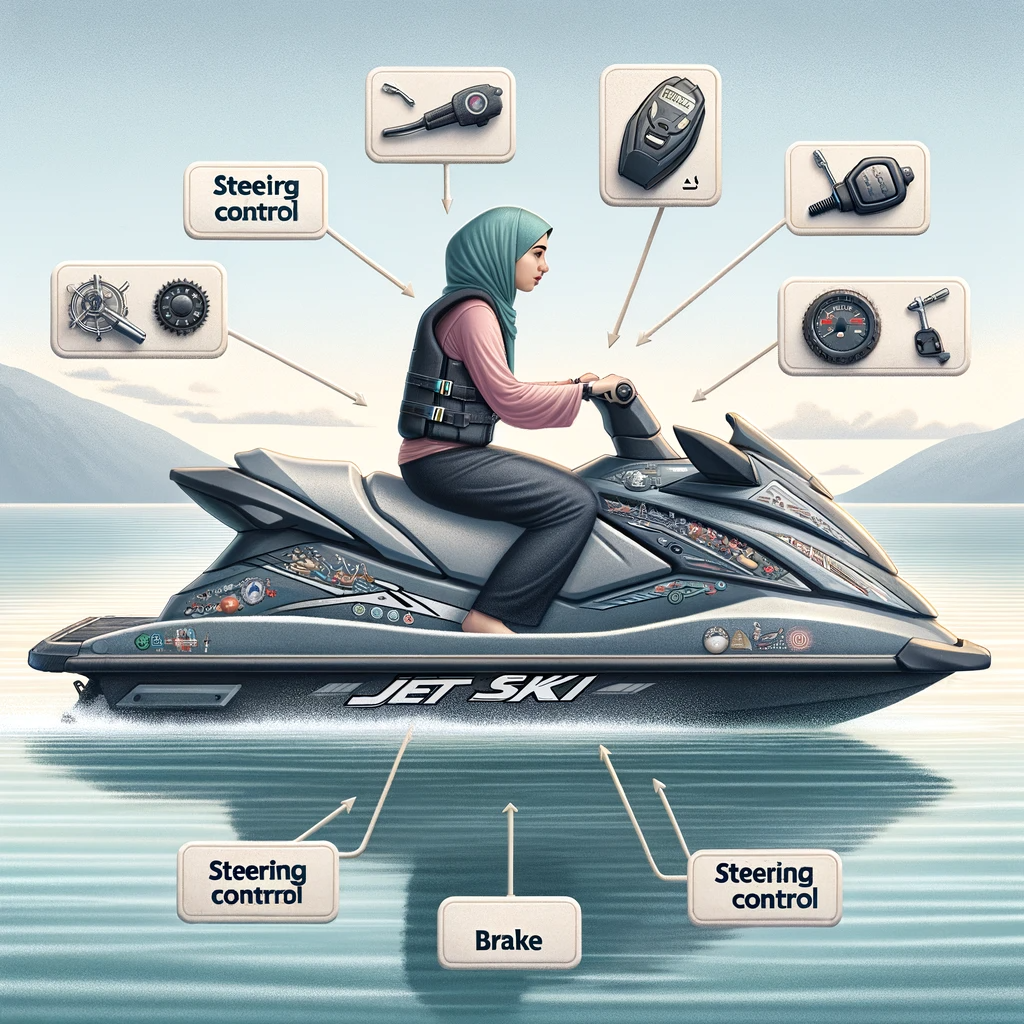A Beginner’s Guide to Basic Jet Ski Operation and Controls

Are you a beginner looking to dive into the thrilling world of jet skiing? Look no further! This article serves as your friendly guide to understanding the basics of jet ski operation and controls. Whether you’re heading out on the open waters for the first time or just need a refresher, we’ve got you covered. From understanding the key components of a jet ski to mastering the controls, we’ll walk you through step by step. So, get ready to make waves and have a blast on your jet ski adventure! And if you’re in Orange Beach, Alabama, we highly recommend renting your jet ski from the watersport experts at A2Z Powersport. With their unparalleled knowledge and top-quality equipment, they’ll ensure your experience is nothing short of amazing. So, what are you waiting for? Let’s get you up to speed on basic jet ski operation and controls!
Jet Ski Operation
Jet skiing is a thrilling water sport that allows you to experience the freedom and excitement of speeding across the water. However, before you hop on a jet ski and start zooming around, it’s important to understand how to operate the jet ski safely and effectively. In this article, we will guide you through the basics of jet ski operation and controls to ensure you have a fun and enjoyable experience on the water.
Understanding the Jet Ski
Before we dive into the specifics of operating a jet ski, let’s take a moment to familiarize ourselves with this exciting watercraft. A jet ski, also known as a personal watercraft (PWC), is a small boat that is designed to be ridden by one or two people. It is powered by an inboard engine that propels the watercraft forward with the help of a jet of water. Jet skis are known for their agility and speed, making them a popular choice for water sports enthusiasts.
Pre-ride Inspection
Before you embark on your jet ski adventure, it is crucial to perform a pre-ride inspection to ensure that the watercraft is in good working condition. Start by checking the fuel level and ensuring that there are no leaks. Inspect the hull for any signs of damage or cracks. Check the handlebars, throttle lever, and other controls to make sure they are functioning properly. Lastly, check the security of the lanyard floating key, which is an essential safety feature that will be discussed later in this article.
Mounting and Dismounting
Mounting and dismounting a jet ski may seem like a simple task, but it is important to do it correctly to avoid any accidents or injuries. To mount the jet ski, approach it from the rear and place one foot on each side of the seat. Carefully lower yourself onto the seat while maintaining your balance. To dismount, bring the jet ski to a stop in a controlled manner and turn off the engine. Swing one leg over the seat and then the other, ensuring a smooth and safe exit from the watercraft.
Starting the Jet Ski
Once you are comfortably seated on the jet ski, it’s time to start the engine and get ready for an exhilarating ride. Most jet skis have a simple start/stop button located within easy reach of the rider. Press the start button and listen for the engine to come to life. If the engine fails to start, check that the ignition switch is in the correct position and try again. Once the engine is running smoothly, you’re ready to start exploring the open water.
Throttle Control
Controlling the speed of your jet ski is done through the throttle lever, which is usually located on the right handlebar. Gently squeeze the throttle lever to increase the speed of the watercraft. The more you squeeze, the faster the jet ski will go. To slow down or come to a stop, release the throttle lever gradually. It’s important to remember that sudden or jerky movements of the throttle can cause the jet ski to lurch forward or lose balance, so smooth and gradual adjustments are key.
Steering Techniques
Steering a jet ski is similar to riding a bicycle. The handlebars are used to control the direction of the watercraft. To turn to the left, simply push the left handlebar grip in the desired direction. To turn right, push the right handlebar grip. It’s essential to use your body weight to aid in steering, leaning towards the direction you want to turn. Practice turning in a wide-open area to get a feel for the responsiveness of the jet ski and to improve your maneuvering skills.
Braking and Stopping
Knowing how to effectively brake and come to a stop is crucial for safe jet ski operation. To slow down, gradually release the throttle lever and allow the jet ski to decelerate naturally. If you need to stop quickly, firmly squeeze the handlebars and shift your body weight backward. This will help to bring the jet ski to a stop in a controlled manner. It’s important to remember that jet skis do not have brakes like traditional vehicles, so it’s essential to anticipate stopping distances and adjust your speed accordingly.
Turning and Maneuvering
In addition to basic steering, it’s important to understand how to execute sharp turns and maneuver the jet ski effectively. To make a tight turn, lean into the direction you want to go while applying gentle pressure to the corresponding handlebar grip. This will cause the jet ski to lean and turn more sharply. Practice turning in both directions to improve your maneuvering skills and become more comfortable navigating different types of water conditions.
Dealing with Waves and Currents
When operating a jet ski, you may encounter waves and currents that can impact your ride. It’s important to approach waves at an angle to reduce the impact and prevent the jet ski from being launched into the air. When riding through waves, maintain a steady speed and use your body as a shock absorber by bending your knees slightly. Similarly, currents can affect the stability of the jet ski, so it’s important to be aware of your surroundings and adjust your riding technique accordingly.
Emergency Procedures
While jet skiing is a thrilling and enjoyable activity, it’s crucial to be prepared for any potential emergencies or unforeseen circumstances. Familiarize yourself with the location of the emergency shut-off lanyard, which is typically attached to your wrist or life jacket. In case of an emergency or loss of control, pulling the lanyard will immediately shut off the engine and bring the jet ski to a stop. Additionally, it’s important to have a basic understanding of first aid and have a safety kit on board in case of any minor injuries or accidents.
Jet Ski Controls
Understanding the various controls and features on a jet ski is essential for safe and efficient operation. Let’s take a closer look at the different controls and their functions.
Handlebars
The handlebars on a jet ski allow you to steer the watercraft and provide stability while riding. They are typically equipped with handgrips that offer a comfortable and secure hold. It’s important to familiarize yourself with the feel and responsiveness of the handlebars before taking off on your jet ski adventure.
Throttle Lever
Located on the right handlebar, the throttle lever controls the speed of the jet ski. Squeezing the lever increases the speed, while releasing it slows down the watercraft. The throttle lever requires smooth and controlled movements to ensure a safe and enjoyable riding experience.
Start/Stop Button
The start/stop button is a convenient feature that allows you to quickly and easily start and stop the engine. Located within easy reach of the rider, it provides a hassle-free way to power on and off the jet ski. Remember to always start the engine when you are safely seated on the watercraft and ready to begin your ride.
Ignition Switch
The ignition switch is responsible for activating the electrical system and allowing the jet ski to start. It is typically located near the handlebars or instrument panel. Before starting the engine, ensure that the ignition switch is in the correct position and the jet ski is in neutral.
Reverse Lever
The reverse lever is used to maneuver the jet ski in reverse. It is commonly located on the left handlebar and can be easily activated with your thumb or finger. The reverse lever is crucial when docking or in emergency situations where you need to slow down or stop the watercraft quickly.
Bilge Pump Switch
The bilge pump switch controls the bilge pump, which is responsible for removing excess water from the hull of the jet ski. It is an important feature that helps to keep the watercraft buoyant and maintain its performance. Familiarize yourself with the location and function of the bilge pump switch to ensure the watercraft remains in optimal condition.
Emergency Shut-Off Lanyard
The emergency shut-off lanyard is a vital safety feature that should be worn at all times while operating a jet ski. It is typically attached to your wrist or life jacket and connects to the jet ski’s engine kill switch. In the event of an emergency or loss of control, pulling the lanyard will instantly shut off the engine, bringing the watercraft to a stop and ensuring your safety.
Fuel Gauge
The fuel gauge provides a visual indication of the amount of fuel remaining in the jet ski’s tank. It is important to monitor the fuel gauge regularly to avoid running out of fuel while out on the water. Always ensure that you have enough fuel for your intended ride and consider refueling if the gauge indicates a low fuel level.
Lanyard Floating Key
The lanyard floating key is a small device that attaches to the emergency shut-off lanyard. It serves as a security measure to prevent unauthorized use of the jet ski. When the lanyard floating key is not in close proximity to the watercraft, the engine is disabled, ensuring that the jet ski cannot be started or operated by unauthorized individuals.
Navigation and Safety Equipment
Along with the fundamental controls, it is essential to have the necessary navigation and safety equipment on board while operating a jet ski. This includes items such as a compass or GPS device for navigation, a whistle or horn to signal your presence to other watercraft, and personal flotation devices (PFDs) for each passenger on board. It’s important to follow all boating regulations and safety guidelines to ensure a safe and enjoyable experience on the water.
In conclusion, understanding the basics of jet ski operation and controls is essential for a safe and enjoyable experience on the water. By familiarizing yourself with the various components, practicing proper techniques, and adhering to safety guidelines, you can confidently navigate the open water on your jet ski. If you’re looking to rent a jet ski, we recommend reaching out to the watersport experts at A2Z Powersport in Orange Beach, AL. With their expertise and top-notch equipment, you can embark on an unforgettable jet ski adventure. So, get ready to hit the waves and experience the thrill of jet skiing like never before!









